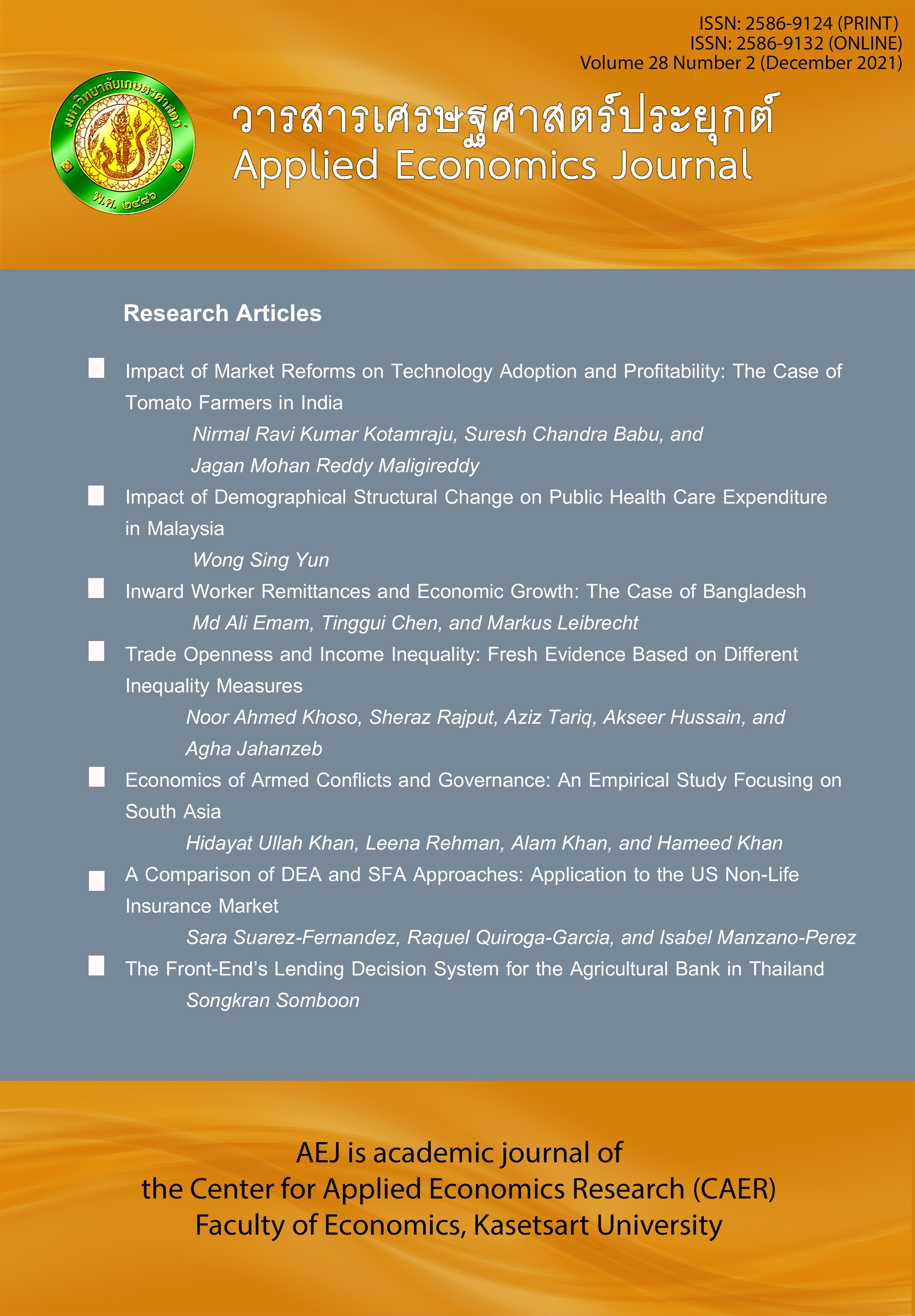Economics of Armed Conflicts and Governance: An Empirical Study Focusing on South Asia
Main Article Content
Abstract
This study examines the effects of governance on armed conflict and the associations between economic factors, external finances (remittances), natural calamities, and armed conflicts. Panel data are used covering the South Asia region from 2002 to 2018, applying the logit and ARDL models. The results show that government effectiveness, political stability and absence of violence/terrorism, and regulatory quality, the rule of law, and droughts/floods have a negative relationship, with the dependent variable, armed conflict. On the other hand, we find that population and remittances, and Voice and Accountability have positive association with armed conflict, as per logit analysis. Based on ARDL estimations, government effectiveness, a proxy variable for governance, political stability and absence of violence/terrorism, and the rule of law have negative and highly significant association with armed conflict. We imply that with an increase in terrorist activities, the governance level, political stability, the rule of law, and regulatory quality deteriorate. In other words, good governance can reduce the likelihood of armed conflict, while population and remittances can fuel armed conflict. Moreover, natural calamities have an inverse relationship with armed conflict. Surprisingly, conflicts help increase the voice of and demand for accountability by general public in the conflict zone.
Article Details
The paper is published under CC BY-NC-ND, in which the article is freely downloaded and shared in its original form non-commercially and its citation details are identified.
References
Akhmat, G., Zaman, K., Shukui, T., & Sajjad, F. (2014). Exploring the root causes of terrorism in South Asia: Everybody should be concerned. Quality and Quantity, 48(6), 3065–3079.
Asongu, S. A., & Nwachukwu, J. C. (2017). The impact of terrorism on governance in African countries. World Development, 99, 253–270.
Basedau, M., Pfeiffer, B., & Vüllers, J. (2016). Bad religion? religion, collective action, and the onset of armed conflict in developing countries. Journal of Conflict Resolution, 60(2), 226–255.
Brooks, N., Adger, W. N., & Kelly, P. M. (2005). The determinants of vulnerability and adaptive capacity at the national level and the implications for adaptation. Global Environmental Change, 15(2), 151–163.
Chi, P. C., Bulage, P., Urdal, H., & Sundby, J. (2015). A qualitative study exploring the determinants of maternal health service uptake in post-conflict Burundi and Northern Uganda. BMC Pregnancy and Childbirth, 15(1), 1–14.
Coccia, M. (2018). A theory of general causes of terrorism - high population growth, income inequality and relative deprivation. Archives of Psychology, 2(4), 22–47.
DFID. (2006). Governance, development and democratic politics: DFID’s work in building more effective states. London.
Enders, W., & Sandler, T. (2000). Is transnational terrorism becoming more threatening? A time-series investigation. Journal of Conflict Resolution, 44(3), 307–332.
Humphreys, M., & Weinstein, J. M. (2008). Who fights? the determinants of participation in civil war. American Journal of Political Science, 52(2), 436–455.
Institute for Economics and Peace. (2017). Global Terrorism Index: Measuring and understanding the impact of terrorism. Institute for Economics and Peace, 1–107. Retrieved from www.economicsandpeace.org
Iyer, L. (2011). The Bloody Millennium: Internal Conflict in South Asia. Harvard Business School BGIE Working Paper No.09-086.
Justino, P. (2011). The impact of armed civil conflict on household welfare and policy. IDS Working Papers, 2011(384), 1–38.
Khalid, U., Okafor, L. E., & Aziz, N. (2020). Armed conflict, military expenditure and international tourism. Tourism Economics, 26(4), 555–577.
Khan, H., Khan, U., Jiang, L. J., & Khan, M. A. (2020). Impact of infrastructure on economic growth in South Asia: Evidence from pooled mean group estimation. The Electricity Journal, 33(5), 106735. 5
Khan, S. U., Khalid, A., & Elahi, N. (2020). Old wine in a new bottle: Governance, fragility and armed conflict trio in Swat Valley, Pakistan. Cogent Social Sciences, 6(1), 1–18.
King, E., & Mutter, J. C. (2014). Violent conflicts and natural disasters: The growing case for cross-disciplinary dialogue. Third World Quarterly, 35(7), 1239–1255.
King, E., & Mutter, J. C. (2015). Natural disasters and violent conflicts. In J. F. Shroder, A. E. Collins, S. Jones, B. Manyena, & J. Jayawickrama (Eds.), Hazards, Risks and, Disasters in Society (pp. 181–198). Amsterdam: Elsevier.
Kreutz, J. (2010). How and when armed conflicts end: Introducing the UCDP conflict termination dataset. Journal of Peace Research, 47(2), 243–250.
Makinda, S. M. (2003). Global governance and terrorism. Global Change, Peace & Security, 15(1), 43–58.
Morse, R. S. (2011). The practice of collaborative governance. Public Administration Review, 71(6), 953–957.
Morse, S. (2019). Corruption Perception Index. In S. Morse (Ed.), The rise and rise of indicators: Their history and geography (pp. 155–170). New York: Routledge.
Oh, C. H., & Oetzel, J. (2011). Multinationals’ response to major disasters: How does subsidiary investment vary in response to the type of disaster and the quality of country governance? Strategic Management Journal, 32(6), 658–681.
Pesaran, M. H., Shin, Y., & Smith, R. J. (2001). Bounds testing approaches to the analysis of level relationships. Journal of Applied Econometrics, 16(3), 289–326.
Seitz, M., Tarasov, A., & Zakharenko, R. (2015). Trade costs, conflicts, and defense spending. Journal of International Economics, 95(2), 305–318.
Wegenast, T. C., & Basedau, M. (2014). Ethnic fractionalization, natural resources and armed conflict. Conflict Management and Peace Science, 31(4), 432–457.
Yiew, T. H., Habibullah, M. S., Law, S. H., & Azman-Saini, W. N. W. (2016). Does bad governance cause armed conflict? International Journal of Applied Business and Economic Research, 14(6), 3741–3755.


